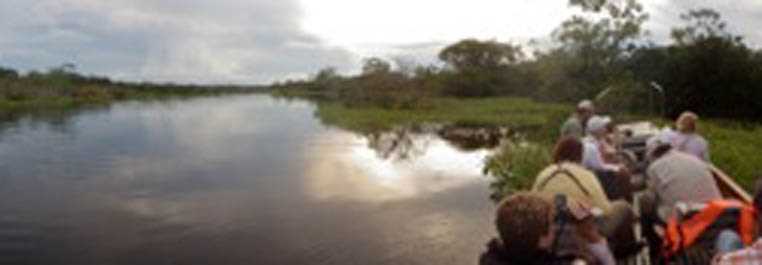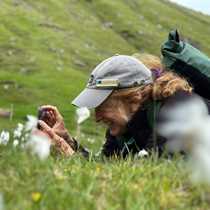Describing our experiences and sightings for today is going to sound like we were choosing swatches at a fabric store or paint chips at a home improvement mart. We started with crossed fingers, hoping the macaws would be in an area off the Río Ucayali where there are a number of dead and topless palm trees. The hollow cavity resulting is a favored nest and roost site of the macaws. Our luck held and several blue-and-yellow macaws were found clambering amongst the palms, hanging upside-down from tree limbs and flying about.
Continuing our search up Belluda Caño, a pair of adorable sea-foam green Tui parakeets, each with a yellow thumbprint on their head, was found perched in a leafless tree. Amongst the streamside vegetation the lemon-yellow plumage of a blackbird oriole caught our attentions, as well as the soft russet colors on the breast of a low-perched black-collared hawk. One of the termite nests in the canopy had stripes, which turned out to be a sloth still curled into a tight ball, not ready to face the morning or us until the sun was higher and warmer. Some of the trees had odd bumps on the branches, which turned out to be green iguana knees, as the lizards laid parallel with the tree branches until the triangles of their folded legs gave them away.
After breakfast we returned to the river and came back with a barrel of monkeys. Well, almost. We started with a troop of saddleback tamarins and then found a couple of the impressive monk saki monkeys; their limp fluffy tail is a great marker as they skulk in the shadows of the canopy. The winner of the paint chips contest was the plum-throated continga, about a robin-sized bird wearing poster paint neon-turquoise. Hard to believe nature can create such brilliance. The radiant red of the lineated woodpecker caught our attentions as it flew from a dead snag, our disappointment with its departure quickly turned around as a female cream-colored woodpecker was on the same tree and stayed put, allowing us wonderful views of her light mustard-colored plumage. With a little skillful maneuvering, our skiff driver penetrated into the flooded forest and brought us to the base of a tree, which was home to a family of night monkeys. They stared wide-eyed at us from the safety of their daytime refuge. Being nocturnal animals, I think they stare at everything wide-eyed. A red blotch was seen swimming in the water, which quickly materialized into an undulating dog-paddling caiman lizard.
For the second half of our day we took to the skiffs once more, this time going up the Río Dorado. The varzea or flooded forest gave us endless opportunities for exploration. A white-eared jacamar with an impossibly long and thick bill sat patiently in a cecropia tree. More sloths were found, one sprawled and basking, appearing to enjoy the late afternoon sun shining on its belly. More macaws flew about and as the light faded, a serenade by horned screamers echoed through the forest. Other chirps, creaks, honks, and peeps started as the nighttime troubadours proceeded to warm up and replace the daytime chorus.
As we returned home, the colors of the day faded, the stars sparked above and the fireflies flickered their butt-glowing Morse code in the shrubbery. A truly diverse, colorful, and satisfying day for everyone.







